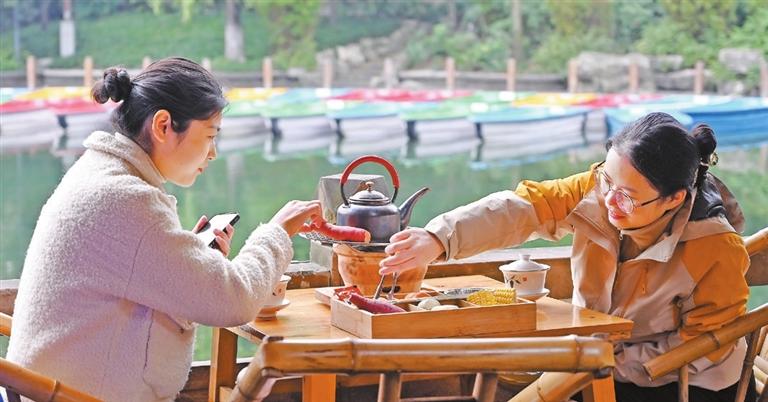
TEA is often associated with a diverse range of characteristics such as variety, color and aroma, but in recent times, the tea culture has gained significant attention in China, especially as a social pastime. Since the end of last year, serving tea on a stove along with dried snacks has been popular in China. At a cafe in downtown Beijing, pu’er tea, a type of fermented tea that is renowned for its exquisite fragrance, is prepared on a stove using vermilion clay teapots. A range of delectable snacks like persimmon, jujubes and peanuts are scattered around the pots, as well as being heated, adding to the overall ambiance. “Brewing tea demands patience. Friends gather around a stove, chat, drink tea and appreciate the tranquility. Such an ambiance provides a momentary respite to escape the clamor of daily life and embrace a sense of calm,” said Tong Shanshan, 31, owner of the cafe. “This place of historical heritage offers a blend of history and modernity,” Tong said, adding that visitors can enjoy stunning views of hutongs, the Drum Tower and Shichahai Lake from the bar’s terrace and capture memorable selfies. In the cafe, a basic tea set costs 268 yuan (US$39) for two to four persons. “This new tea-drinking activity has encouraged more young people to embrace tea culture,” Tong said. In the past winter, serving tea on a stove has ridden the wave of reviving traditional Chinese style, becoming a social media fad. There are more than 750,000 notes about the topic on Xiaohongshu, China’s lifestyle-focused social media platform, and nearly 5 billion video views on Douyin. Zhang Xuange, a tourist in Beijing from Northeast China’s Shenyang City, said he enjoyed interactions with friends when drinking tea beside a stove. Over the past decade, along with the expanding middle class in China and the doubling per capita disposable income, the market of new tea beverages, including tea drinks combined with fresh fruits, has boomed. Chinese tea has a rich history of traversing borders and time, thanks to the ancient Silk Road and the Tea Horse Road. Today, the sought-after commodity continues to demonstrate its vitality in the modern world, while also receiving recognition from the global community. In 2022, traditional Chinese tea-making techniques were included in the UNESCO Representative List of Intangible Cultural Heritage of Humanity. At Wuyutai Tea Shop on Qianmen Street, a major commercial hub in Beijing, customers can be seen lining up to buy specialty tea-flavored ice cream. The brand, established in 1887, has gained a reputation for its exquisite jasmine tea. With over 500 outlets across China, the company is undergoing a transformation to cater to the preferences of young people. “We have noted the market changes and developed the tea-flavored ice cream in 2008. It is popular among customers, and more than 30 branches sell the product,” said Zhao Shuxin, chairman of the board of Wuyutai Tea. “More new forms of Chinese-style consumption will spring up in the future,” said Tang Xin, who heads the research institute of municipal affairs under the Beijing Academy of Social Sciences. (Xinhua) | 
